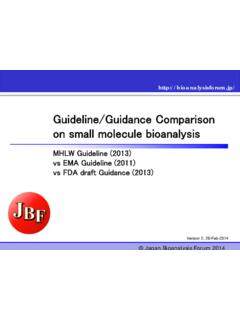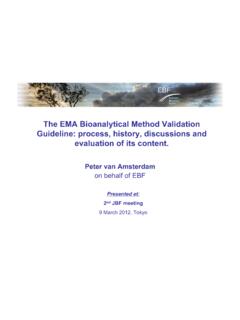Transcription of Guideline/Guidance Comparison on Ligand Binding Assays …
1 Guideline/Guidance Comparison on Ligand Binding Assays (LBA) MHLW LBA Guideline (2014) vs EMA Guideline (2011, updated 2014) vs FDA draft guidance (2013) Japan Bioanalysis Forum 2015 Scope 2 MHLW LBA Guideline (2014) This guideline is applicable to the validation of LBAs as analytical methods for the measurement of drugs in biological samples obtained in toxicokinetic studies and clinical trials, as well as to the analysis of study samples using such methods. The information in this guideline generally applies to the quantification of peptides and proteins as well as low-molecular-weight drugs that are analyzed by LBAs.
2 A typical example of an LBA is an immunological assay based on antigen-antibody reaction, such as enzyme immunoassay (EIA). This guideline is not mandatory for analytical methods used in non-clinical studies that are beyond the scope of Ministerial Ordinance Concerning the Standards for the Conduct of Non-clinical Studies on the Safety of Drugs (Ministry of Health and Welfare ordinance No. 21, dated March 26, 1997), but could be used as a reference for conducting the required validation of such methods. EMA Guideline (2011) Similar to Japanese Guideline, but focused analytes are not given.
3 FDA draft guidance (2013) Similar to Japanese Guideline, but nonclinical pharmacology study is in the scope. A chapter of LBA is given independently. Additionally, Endogenous Compounds, Biomarkers, Diagnostic Kits and New Technologies are mentioned. Applicability to veterinary drug Underline: key words in the item Japan Bioanalysis Forum 2015 Reference standards 3 MHLW LBA Guideline (2014) A reference standard serves as the scale in quantifying an analyte, and is mainly used to prepare calibration standards and quality control (QC) samples, which are relevant blank matrix spiked with a known concentration of the analyte of interest.
4 The quality of the reference standard is critical, as the quality affect measurement data. A certificate of analysis or an alternative statement that provides information on lot number, content (amount, purity, or potency) and storage conditions should accompany the standard. Also, the expiration date or its equivalent is preferably clarified. As for a reference standard, it is important that the material is procured from an authenticated source and is of well-controlled quality. EMA Guideline (2011) Similar to JPN guideline, but additional cautions about the consistent use of the same lot of standard and the change of lot of standard are mentioned.
5 FDA draft guidance (2013) Detailed requirements are not given, but additional caution on the change of key reagents is mentioned. Underline: key words in the item 3 Japan Bioanalysis Forum 2015 Full validation 4 MHLW LBA Guideline (2014) A full validation should be performed when establishing a new bioanalytical method for quantification of an analyte/analytes. A full validation is also required when implementing an analytical method that is disclosed in literature or commercialized as a kit product. The objective of a full validation is to demonstrate the assay performance of the method, , specificity, selectivity, calibration curve, accuracy, precision, dilutional linearity, and stability.
6 Generally, a full validation should be performed for each species or matrix (mainly plasma or serum) to be analyzed. The matrix used in analytical validation should be as close as possible to the target study samples, including anticoagulants and additives. When an analytical method is to be established for a matrix of limited vailability (rare matrix, , tissue, cerebrospinal fluid, bile) and a sufficient amount of matrix cannot be obtained from sufficient number of sources (subjects or animals), a surrogate matrix may be used to prepare calibration standards and QC samples.
7 However, the use of a surrogate matrix should be justified as much as possible in the course of establishing the analytical method. In an LBA full validation, the minimum required dilution (MRD) should be defined a priori ( , in the course of method development) to dilute samples with buffer solution. When using a plate-based LBA, analysis should generally be performed in at least 2 wells per sample; a sample concentration should then be determined either by calculating a mean of responses from the wells or by averaging the concentrations calculated from each response.
8 EMA Guideline (2011) Similar to Japanese Guideline, but carryover, MRD and parallelism are stated separately. FDA draft guidance (2013) Similar to Japanese Guideline, but selectivity and dilution linearity are not included. Underline: key words in the item 4 Japan Bioanalysis Forum 2015 Full validation: MRD 5 MHLW LBA Guideline (2014) (Addressed in full validation) In an LBA full validation, the minimum required dilution (MRD) should be defined a priori ( , in the course of method development) to dilute samples with buffer solution.
9 (Addressed in glossary) A dilution factor where biological samples are diluted with buffer solution for the analysis by LBAs. The MRD may not necessarily be the ultimate minimum dilution but should be identical for all samples including calibration standards and QC samples. EMA Guideline (2011) Similar to Japanese Guideline, but MRD means the smallest dilution. FDA draft guidance (2013) Not addressed Underline: key words in the item 5 Japan Bioanalysis Forum 2015 6 MHLW LBA Guideline (2014) Specificity is the ability of an analytical method to detect and differentiate the analyte from other substances, including its related substances ( , substances that are structurally similar to the analyte).
10 For an LBA, it is important that the Binding reagent specifically binds to the target analyte but does not cross-react with coexisting related substances. If presence of related substances is anticipated in biological samples of interest, the extent of the impact of such substances should be evaluated. Specificity may be evaluated in the course of method development. In some cases, an additional specificity testing may have to be conducted after a method validation is completed. Specificity is evaluated using blank samples (matrix samples without analyte addition) and blank samples spiked with the related substance at concentration(s) anticipated in study samples; in addition, QC samples with the analyte concentrations near the lower limit of quantification (LLOQ) and near the upper limit of the quantification (ULOQ) of calibration curve should be evaluated after spiking with the related substance at anticipated concentration(s).


